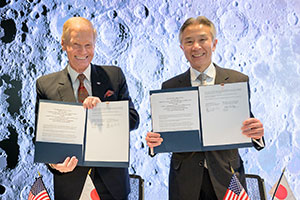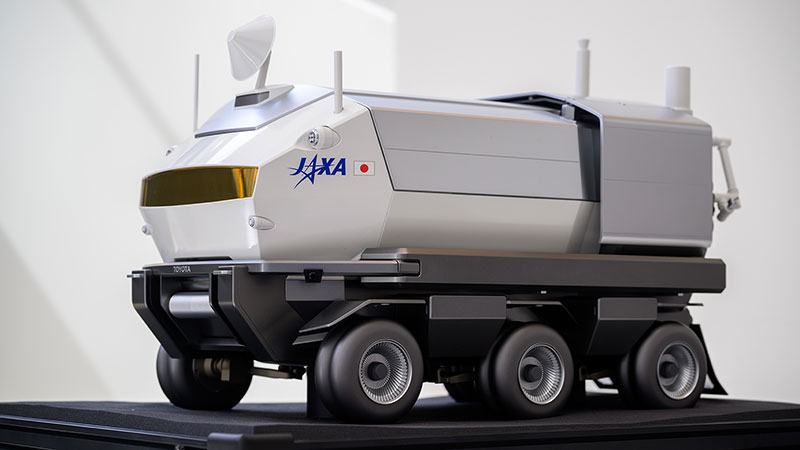 advertisements advertisements
|

|
Japanese astronauts will join NASA moon landings in return for rover
April 10, 2024 — The first non-American to walk on the moon will be a Japanese astronaut, based on a new agreement between the United States and Japan.
U.S. President Joe Biden announced the goal during a state visit by Japan's prime minister, Kishida Fumio, on Wednesday (April 10).
"The science and education ties between Japan and the United States ... stretch up to the moon, where two Japanese astronauts will join future American missions, and one will become the first non-American ever to land on the moon," said Biden, speaking from the Rose Garden at the White House.
"In the first half of the 1960s, when I was in the United States, it was the dawn of space development in the United States. I am one of all those who were so excited in the U.S. by the spectacular challenge in space," said Fumio. "Under the Artemis program, I welcome the lunar landing by a Japanese astronaut as the first non-U.S. astronaut."
To date, only 12 humans — all Americans — have landed on the moon as part of NASA's Apollo program, from 1969 to 1972. The U.S. Artemis program seeks to return astronauts to the moon as soon as late 2025, with the first landing targeted for the program's third mission in 2026.
The four-member Artemis II crew includes the first woman, the first person of color and first non-American to fly to the moon, the latter a Canadian.
The new Lunar Surface Exploration Implementing Arrangement signed by NASA Administrator Bill Nelson and Japan's Minister of Education, Culture, Sports, Science and Technology (MEXT) Masahito Moriyama does not specify on what Artemis lunar landings missions the Japan Aerospace Exploration Agency (JAXA) astronauts will fly, but does note that the flights rely on "important benchmarks" being met.
"Japan will develop for NASA's use a pressurized rover," said Nelson in a video statement. "It is going to lead us to cover ground we've never covered before, because [the astronauts] will be out and can stay for several days on the surface. That means cover it literally, scientifically and diplomatically."
Since 2019, JAXA and Toyota have been collaborating on the development of a pressurized lunar rover that incorporates Toyota's fuel cell technology to provide power to the vehicle. The "Lunar Cruiser," which was named after Toyota's Land Cruiser, is designed to serve as a camper van for multi-day excursions.
"It is a mobile habitat, it's a lunar lab, a lunar home and a lunar explorer. It's a place where astronauts can live, work and navigate the lunar surface, leading to magnificent discoveries for all of us," said Nelson.
Japan will not only provide the new pressurized rover, but also operate it on the lunar surface, with or without astronauts on board. The Lunar Cruiser, which NASA will launch and deliver to the moon, is expected to ready by 2031 for use by the Artemis VII crew and then serve subsequent missions over the course of 10 years.
"The pressurized rover will be a powerful contribution to the overall Artemis architecture as Japan and the U.S. go hand in hand with international and industry partners to the lunar surface and beyond," said JAXA's President Hiroshi Yamakawa. "JAXA is ready to assist MEXT and push this forward with our science and technological expertise to establish sustainable human presence on the moon."
The Japanese rover is intended to complement a smaller, unpressurized vehicle now being developed by three U.S. companies. Intuitive Machines, Lunar Outpost and Venturi Astrolab are each working on concepts for a Lunar Terrain Vehicle (LTV) for use by Artemis astronauts on shorter range excursions.
In addition to landing two Japanese astronauts on the moon, NASA and JAXA have previously agreed to fly a JAXA crew member to the lunar orbit Gateway in return for Japan providing the human-tended platform's environmental control and life support systems, as well as augmenting its cargo transportation needs.
JAXA currently has five active astronauts — Satoshi Furukawa, Akihiko Hoshide, Kimiya Yui, Takuya Onishi and Norishige Kanai — and in 2023, recruited two more candidates — Makoto Suwa and Ayu Yoneda — to train for future moon missions.
"What better representation of the promise of partnership than President Biden's announcement today that America will no longer walk on the moon alone," said Nelson.
|
|

JAXA President Hiroshi Yamakawa (left), JAXA astronaut Akihiko Hoshide, Japan's Minister of Education, Culture, Sports, Science and Technology Masahito Moriyama, NASA Administrator Bill Nelson and NASA astronaut Kayla Barron talk by a model of Japan's pressurized lunar rover after the signing of an agreement to advance sustainable exploration of the moon. (NASA/Bill Ingalls)

U.S. President Joe Biden (right) and Japan's Prime Minister Kishida Fumio announced the shared goal for a Japanese national to be the first non-American astronaut to land on the moon on a future Artemis mission, on Wednesday, April 10, 2024. (The White House)

NASA Administrator Bill Nelson and Masahito Moriyama, Japan's Minister of Education, Culture, Sports, Science and Technology, hold signed copies of an agreement between the United States and Japan to advance the exploration of the moon. (NASA/Bill Ingalls) |

A model of the Japan's pressurized lunar rover ("Lunar Cruiser") concept is seen during a briefing at the Japan Aerospace Exploration Agency (JAXA) offices in Washington, D.C., on Wednesday, April 10, 2024. (NASA/Bill Ingalls) |
|

© 1999-2025 collectSPACE. All rights reserved.
|
|

|

|
